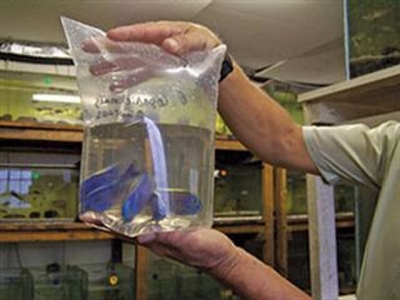Moving fish

Special care needs to be taken when moving fish in order to minimise their stress levels and thus prevent unnecessary deaths.
Ornamental fish packed for air transport prior to double-bagging. Photo: Nicolas James
In aquaculture, fish are frequently moved from one location to another. As can be expected, this is stressful for them and can have long-term negative effects if done incorrectly. Unfortunately, many people in the industry fail to appreciate what the fish go through when they are wrenched from their natural environment, crammed into confined spaces and subjected to sudden changes in water quality.
One of the common mistakes made by fingerling sellers is to pack and transport fish that have fed recently. Tilapia have extremely long intestines, and can retain food in their gut for more than 48 hours. If such fish are caught and packed in great numbers in a container, losses are inevitable. Within a few minutes the stressed fish will excrete such large volumes of waste that the water becomes turbid and highly toxic.
Despite this, many fingerling ‘distributors’ regularly pack recently netted wild fish, thus delivering to their customers fish poisoned by their own waste products. The gills of these fish are burnt by the ammonia in the water, which destroys the fragile surfaces of the lamellae and removes much of the protective slime-coating on the fish’s skin. Pathogens, which are always present in water and on the fish themselves, can then enter the fish, which become sick and die a few days later.
Avoid the poisons – purge
The only way to transport such fish is to purge them for several days beforehand in clear water. If there is any sign of faeces soon after packing, the fish have not been purged sufficiently. Fry up to 30mm can be packed at high densities if well-prepared, and transported over long distances for extended periods. We pack 500 fry in a 5l plastic bag, with two bags per box. This reduces the high transport cost to less than 30c/fish.
Bag problems
If the fish are packed at high densities and a few die early on, their decomposing bodies cause a drastic reduction in water quality, and more fish will die as a result. This chain reaction can result in 100% mortality in the container. I’m also still amazed at how many ‘professional’ fish packers don’t double up on bags. Doing so, and putting the inner bag upside down to prevent the small fry from becoming trapped in the corners, should be standard procedure.
Short-distance transportaton
At the hatchery, too, fish need to be transported for testing, stocking of grow-out tanks and so forth. These distances, however, are short and require no more than buckets of clean water. Remember, though, that at high densities, the fish will soon rise to the surface and begin gasping as the oxygen is depleted. Mortalities will follow if the fish are not rescued in time.
Small battery-powered air blowers are a useful tool here. These are available from aquarium shops at a reasonable price. They can be clamped to the bucket with a short airline and air-stone. Larger fish can be transported in 100l plastic drums (200l drums are too heavy) readily and cheaply available from recyclers. The drums can be packed into a bakkie and fish as large as 2kg transported in this way.
I strongly recommend the use of a 12V air-blower plugged into the vehicle’s electrical system and feeding large air-stones.
A sedative in the water is also essential. Finally, if you require fingerlings, ask your supplier if he uses sedatives and purging oxygen. If he doesn’t, buy elsewhere!
Related news
 Why aquaculture is stressful for fish
Why aquaculture is stressful for fish Fish species that are adapted for rivers generally perform better under aquaculture’s challenging conditions. Why aquaculture is stressful for fish
 Small scale fish farming
Small scale fish farming With government assistance, many rural small-scale fish farmers could turn their operations into viable enterprises.
 Cold-tolerant tilapia can weather winter’s chill
Cold-tolerant tilapia can weather winter’s chill Taking tilapia cold tolerance ranges into account shows how just a few degrees can make for a worry-free season.